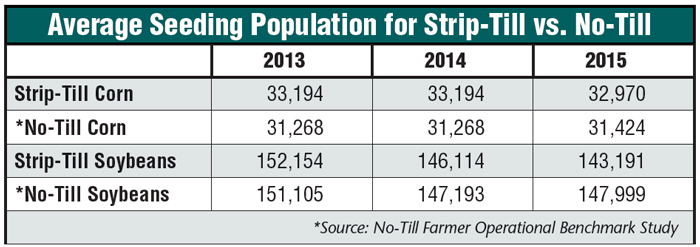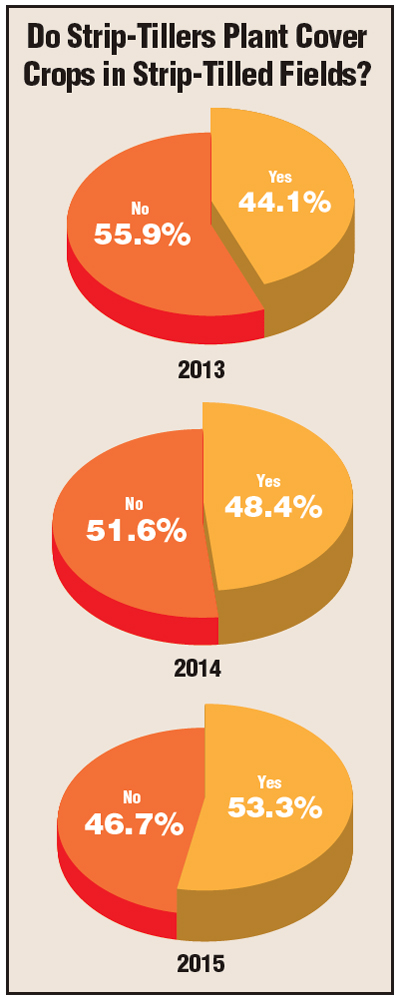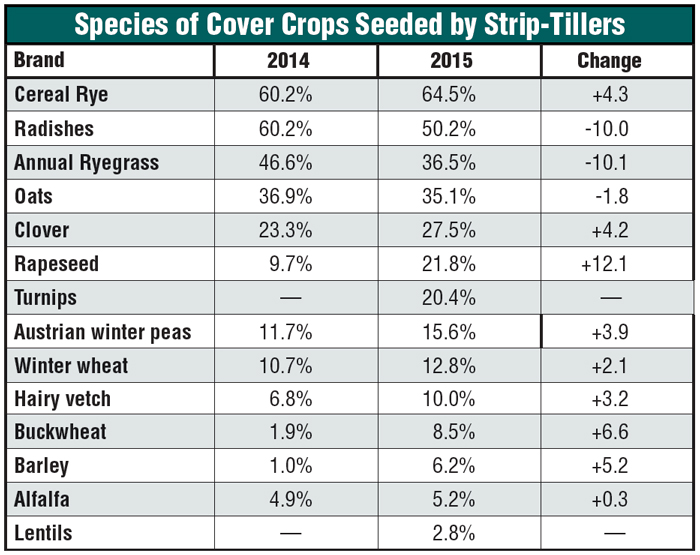
As strip-tillers search for efficient, economical ways to retain moisture and nutrients in their soils, an increasing number are turning to cover crops. Analysis of the 3rd Annual Strip-Till Operational Benchmark Study revealed another uptick in their use.
The number of farmers planting cover crops in strip-tilled fields topped 50% for the first time, and continued a steady increase during the last 3 years. The 2016 study showed that 53.3% of strip-tillers planted cover crops last year, up from 48.4% in 2014 and 44.1% from 2013.
While these figures don’t yet compare to the 72.7% of no-tillers who planted cover crops in 2015, according to No-Till Farmer’s 8th Annual No-Till Operational Benchmark Study, it will be worth watching whether use among strip-tillers continues to increase.
For the second year, farmers were asked to identify which types of cover crops they’re seeding into strip-tilled fields. Once again, cereal rye was the most popular species, with 64.5% seeding this cover, up more than 4 percentage points from 2014.
Second most popular by a wide margin were radishes at 50.2%. However, this number was down by about 10 percentage points year-over-year. Also seeing a substantial decline was ryegrass, from 46.6% according to last year’s study, to 36.5% in 2015.
The biggest gain came in the percentage of strip-tillers using rapeseed, which jumped from 9.7% to 21.8%. Also seeing sizeable increases were buckwheat from 1.9% to 8.5% and barley from 1% to 6.2%.

New additions to the list this year were turnips, used by 20.4% of survey respondents, and lentils, which were grown by 2.8%.
Twin-Row Increase
While strip-tillers were able to maintain the same per-bushel average for corn yields, they did so by decreasing their average seeding population, albeit slightly. After 2 years of identical rates of 33,194 seeds per acre, the average fell to 32,970 in 2015 — a decrease of 224 seeds per acre.
While not a significant decrease, it was still above the 31,424 seeds-per- acre average for no-tillers as reported in No-Till Farmer’s benchmark study.
Strip-tillers were more judicious with their soybean populations in 2015, planting an average of 143,191 seeds per acre, about 3,000 seeds less per acre than the year prior (146,114) and nearly 9,000 less than 2013 (152,154). The 2015 total was less than the average no-till soybean population of 147,999 seeds per acre, as reported by the No-Till Farmer benchmark study.
Perhaps the most interesting change in seeding practices was the continued adoption of twin-row strip-till. The percentage of strip-tillers utilizing the system has more than doubled during the last 3 years, starting at 2.9% in 2013, to 4.7% the following year and 6.3% in 2015.
This was more than three times the 1.9% of no-tillers planting twin-rows, down from 3.5% in 2014, according to No-Till Farmer’s benchmark study
The Top 10%
Examining the top-yielding strip-tillers’ seeding practices, 68.8% utilized cover crops, about 15% higher than the overall group, with the most popular varieties being cereal rye (72.7%), oats (45.5%) and annual ryegrass (36.4%).
The top 10% averaged a corn planting population of 34,750, about 1,700 more seeds per acre than the overall group. Average seeding rates for strip-tilled soybeans were 142,902, slightly less than the overall average of 143,191.
As was the case with the overall group, more high-producers practiced twin-row strip-tilling. Last year, 15.6% utilized twin-rows vs. less than 1% in 2014.







